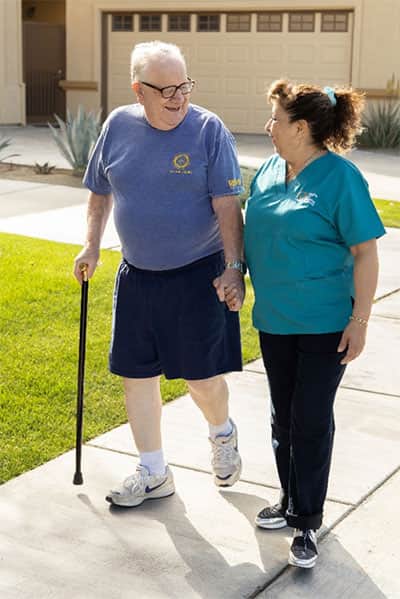

Seven Surprising Things That Could Cause a Fall
Seven Surprising Things That Could Cause a Fall
The subject of fall prevention has always been important for older adults, their families, and the professionals who support their well-being. Consider the statistics:
- Each year, one-third of people older than 65 will fall.
- Many will suffer a fracture, brain damage or other debilitating injury.
- On average each day, 75 older adults will die from the effects of a fall.
- Falls cost our healthcare system upwards of $50 billion every year.
- More than 3 million older adults go to the emergency room annually with fall-related injuries.
And these days, avoiding falls could help avoid a trip to the emergency room, where a vulnerable senior could be exposed to COVID-19. Jill Breysse, a researcher at the National Center for Healthy Housing, recently told the American Heart Association, “It’s very important in general to take steps to prevent falls, but the current situation is a reminder of things we should be doing all of the time.”
It’s important to talk to older loved ones about the basics of fall protection:
- Remove fall hazards from the home.
- Have regular eye exams.
- Wear sturdy, properly fitted shoes.
- Have medications reviewed.
- Report balance problems to your doctor.
- Get plenty of the right kind of exercise.
- Wear hearing aids.
- Limit alcohol consumption.
But many elders avoid these conversations. On the defensive, they feel as if their competence is being questioned. For a change of strategy, share some new information. Make it a current events discussion that could be a welcome detour from today’s constant infection control warnings. Here are some recent and sometimes surprising findings that can serve as conversation starters:
1. Foot problems are a bigger risk factor than we thought. Researchers from Harvard School of Public Health noted that when a senior falls again and again, sore feet or flat feet are often the cause. Said professor and epidemiologist Marian Hannan, “We know that having more than one fall can be of concern. Many don’t think of feet as the culprit. However, higher odds of recurrent falls were seen for those with foot pain, especially severe foot pain, as well as those with planus foot posture (flat feet), indicating that both foot pain and foot posture may play a role in falls.” Hannan’s team says that treating foot problems could significantly reduce fall injuries and the resulting loss of independence among older adults.
2. A car crash can raise a senior’s risk of falling — and the reverse also is true. Reduced body strength and flexibility, balance problems and vision loss can make both walking and driving less safe. Falls and car accidents are further interrelated, said experts from the AAA Foundation: When a senior has a car accident, resulting injuries and emotional trauma can raise their risk of falling. Coming full circle, senior drivers who have suffered a fall are then at higher risk of having a car crash, due to the effects of injuries and perhaps inactivity.
3. Vision problems begin to cause falls early on. Many people consider falls to be a problem exclusive to seniors. In fact, between the ages of 40 – 60, around 10% of people will experience a serious fall, noted experts from the University of Michigan. As assistant professor Carrie Karvonen-Gutierrez said, “Do we hit the magic number of 65 years old and suddenly become at risk for falls, whereas we are somehow immune before that? Certainly not.” Karvonen-Gutierrez and her team believe that many of these falls are caused by treatable vision problems, such as nearsightedness.
4. The role of medications is a complicated one. A second University of Michigan study examined the relationship between depression, depression medications and falls. The researchers noted that depression raises the risk of falls — but so do many of the medications commonly prescribed for older adults with depression. The researchers urged doctors to carefully calibrate a senior’s use of these medicines. Another study, this one from Penn State University, noted that seniors who have poor sleep may get out of bed during the night, which can lead to a fall — yet if the doctor prescribes a sleep medication, that too can increase the risk of falls. According to professor Orfeu Buxton, these medications “often have side effects that cause problems with balance, memory and situational awareness.” In both studies, the authors recommend nondrug approaches.
5. It takes seniors only milliseconds longer to realize they're falling — but that makes a difference. Researchers from the University of Waterloo in Ontario noted that it takes seniors twice as long to realize they’re falling, as compared to younger adults. Among a group of test subjects, younger adults took 44 milliseconds, while people older than 60 took twice as long — 88 milliseconds. That’s less than one-tenth of a second, but, said associate professor of kinesiology Michael Barnett-Cowan, “This lag means that by the time older adults realize they are falling, it’s often too late for them to consciously do anything about it. These findings highlight both the importance of adequate assessment for older adults and the need to expedite new prevention technology.”
6. Winter isn’t the most dangerous season for falls. Many seniors believe that their greatest risk of a serious fall injury is to slip on an icy sidewalk or other surface during the cold days of winter. But they shouldn’t let their guard down during summer. A study published by the American Society of Anesthesiologists analyzed the instance of hip fracture, one of the most serious consequences of falls. The data showed that, in fact, more than half of these fractures occurred during warmer months. By the same token, staying indoors doesn’t make us safer — more than 75% of falls happen inside. Tripping over a throw rug and falling out of bed were the most common causes. Said study author Dr. Jason Guercio of North American Partners in Anesthesia of New Britain, Conn., “Efforts to decrease fall risk among the elderly living in cold climates should not be preferentially aimed at preventing outdoor fractures in winter, but should focus on conditions present throughout the year, and most importantly on mitigating indoor risk.”
7. Our furry friends can be a fall hazard. Though pet ownership has been found to reduce the risk of falls by keeping us more active and upbeat, the Centers for Disease Control and Prevention (CDC) also warns that about 1% of fall injuries are associated with pets. A senior might be pulled off balance while walking a dog, or trip over a pet in the home. An enthusiastic dog can knock a frail senior off their feet. CDC experts say awareness is the first step: Always be alert for the presence of a pet that could be underfoot. Equip cats and dogs with a bell so you’ll hear them coming. Move pet toys and dishes out of the way. And if you own a too-rambunctious dog, it’s time for obedience school.
Make fall prevention a priority now.
Studies show that fewer than half of older adults tell their doctor when they fall, but that information is important to share. Even if it’s during a virtual visit via telemedicine, talk to your healthcare provider about your fall history and your personal risk factors, and ask for a “prescription” for fall protection.
If your family uses home care to support the well-being of an older loved one, make fall prevention a priority.
- A professional caregiver can keep the home free from hazards, and provide supervision and assistance during activities that could be dangerous, such as bathing, navigating stairways, and getting in and out of bed.
- Caregivers support overall good health by preparing nutritious meals, taking clients to health appointments, and supervising exercise to promote improved strength and balance.
- And though it’s impossible to prevent all falls, families can rest easier knowing that if their loved one were to fall, a trained caregiver would be on hand to assist right away.
Register for the free CEU webinar, “Understanding, Identifying and Addressing Fall Risk in Aging Adults,” that will be held August 26, 2020. The webinar is sponsored by Right at Home and hosted by the American Society on Aging.





